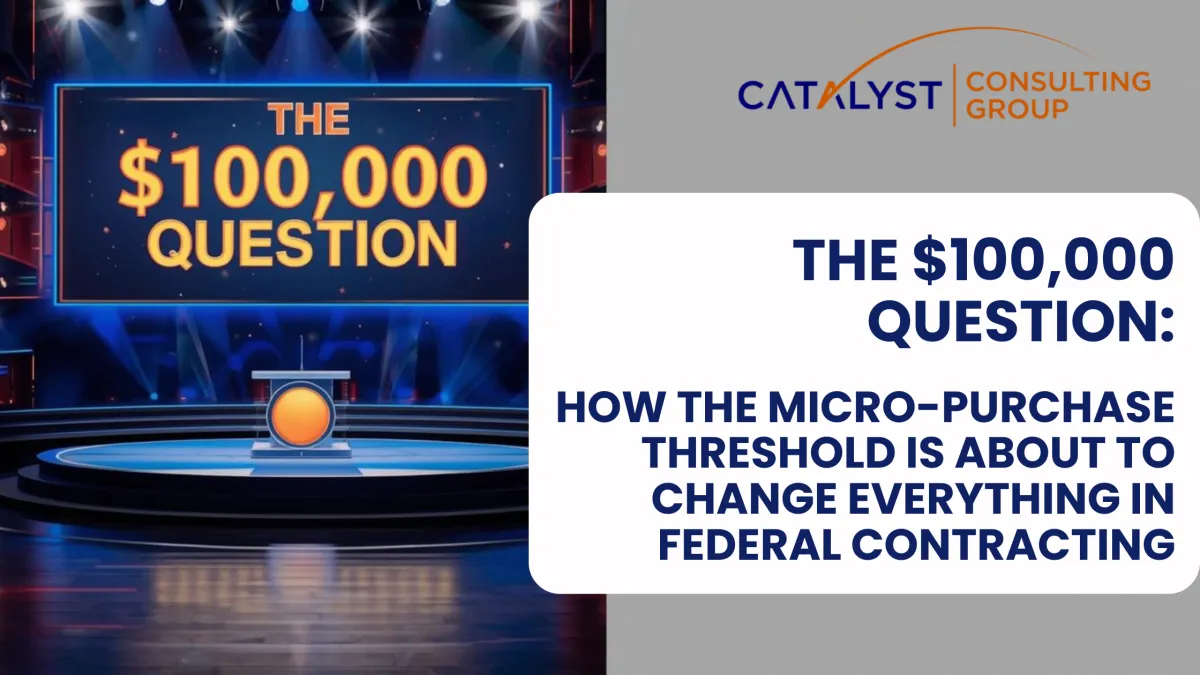
The $100,000 Question: How the Micro-Purchase Threshold is About to Change Everything in Federal Contracting
Welcome to Catalyst Conversations! In a recent discussion, our team—led by Michelle Warren and featuring former GSA Chief of Integrated Marketing Robin Zickgraf and Catalyst's Ryan Hay—dove into the monumental, often-overlooked federal Micro-Purchase Threshold (MPT).
The MPT dictates the ceiling for simplified acquisition, allowing government agencies to bypass red tape and make quick, credit card-based purchases. This seemingly small detail has an enormous impact: "There are over 500,000 transactions annually that are done under this micro-purchase threshold”, accounting for "$18 billion in annual federal spending" (Michelle Warren). For the furniture industry alone, Michelle estimates that "$240 million in furniture today" is done under these guidelines, a number poised to grow significantly.
1. The MPT Defined: Cutting the Red Tape
The MPT is the lowest monetary threshold in the Federal Acquisition Regulations (FAR), where purchasing rules are drastically simplified.
Robin Zickgraf highlighted the history and the most recent change: "When I started my career 20 years ago, it was $2,500". More recently, the threshold jumped from $10,000 to $15,000 on October 1st.
The MPT is critical for vendors because it accelerates sales. Robin notes that MPT transactions eliminate complex bidding and proposal processes: "It eliminates all that red tape. That means they could just call you up and order it - like buying something off of Amazon". He concludes that "doing business under the micro-purchase threshold is a huge benefit for you as a vendor, because it just speeds everything up".
2. The Blockbuster Proposal: $100,000
The truly game-changing news is the legislative proposal currently circulating from the GSA.
The proposal is to dramatically increase the MPT to $100,000 through a phased approach:
Today: $15,000
2027 (Proposed): $25,000
Phase 2 (Proposed): $50,000
Final Destination (Proposed): $100,000
While the timeline may seem long, Robin believes it could accelerate: "The rate that things are changing is dramatic. There is a very strong likelihood that they could change this much sooner, I would say".
3. The New Go-to-Market Strategy
The shift to a $100,000 MPT represents a massive opportunity and a fundamental change in how manufacturers must approach the federal market.
For Vendors:
The change is a "win-win" for both the government and the vendor. As Robin summarized, "The government's going to get what they need much quicker, they don't have to jump through all those hoops, and then you, as the vendor, can get paid quicker. Not only that, but you can open your marketing to customers that you have probably never even considered before, or, new markets that you have never even looked at".
For many small business manufacturers, this change would instantly simplify most of their orders. Robin drove this point home: "If you're doing business and everything you do is under $100,000, this is your lucky day if this becomes reality, because it's going to simplify everything. Dramatically and drastically".
Michelle believes this shift will redefine public sector engagement: "I think it changes the whole landscape of how we create our strategy, how we go after business, the marketing, who we're approaching, how we're approaching it, could all change if this comes to fruition".
A Changing Landscape for GSA Contracts:
The change also affects the value proposition of a GSA contract itself. Michelle asked: "It begs the question for manufacturers; do they even need a GSA contract? Once it gets to 100,000?".
Furthermore, a higher MPT creates an entry point for innovation. Michelle remarked, "This would also be great for innovative products. Products that may not be on the contract for a while, or new companies that come into the space, that must wait 2 years to get a GSA contract. They could come into the space with a really cool product and GSA could then buy it, with that higher threshold amount".
4. The Potential Challenges
While the benefits are clear, the panel also discussed potential drawbacks:
Loss of Visibility: Currently, many purchases over the MPT are publicized (e.g., on eBuy or SAM.gov), offering vendors market intelligence. Ryan Hay noted that increasing the threshold to $100,000 takes this transparency away: "you're trying to break into that, so it's good to see when you can see bids, see what competitors are doing, and actually go after them yourself. So, if you move that to over $100,000, it takes all that away".
Credit Card Fees: Since the transactions are paid via purchase card, Michelle highlighted an issue for vendors: "you have these bigger opportunities up to $100,000, but they're being paid on a credit card. And the seller has to pay that credit card fee".
Conclusion and Next Steps
The proposed $100,000 MPT is not just an administrative change; it is a strategic opportunity that demands a re-evaluation of public sector go-to-market plans. Thank you to Robin Zickgraf and Ryan Hay for sharing their deep insights into this critical change.
If you are interested in elevating your public sector strategy, consider our monthly subscription program, the Public Sector Accelerator.
Our next Catalyst Conversations call is scheduled for Thursday, November 13th, at 4 pm, where we will be conducting a fiscal year 2025 in review. We hope to see you there!
This month, special guest Corey Imhoff with OMNIA Partners joined us as we dove into a critical topic for expanding your sales: selling to the non-profit market using cooperative contracts. Many organizations in this space operate on tight budgets and with lean teams, making them a prime audience for the efficiency and savings offered by cooperative contracts.
Don't Miss the Next Catalyst Conversation!
Mark your calendars! Our next Catalyst Conversation is set for Wednesday, December 11, at 4 p.m. EST. We'll be discussing the changes to selling in Federal/GSA over the last 12 months.
